Physics For Civil Engineering: Unit IV: New Engineering Materials
Shape Memory Alloys (SMA)
Phases, Types, Methods of Processing, Characteristics, Applications, Advantages, Disadvantages
A group of metallic alloys which shows the ability to return to their original shape or size (i.e., alloy appears to have memory) when they are subjected to called shape memory alloys.
SHAPE MEMORY ALLOYS (SMA)
A
group of metallic alloys which shows the ability to return to their original
shape or size (i.e., alloy appears to have memory) when they are subjected to
called shape memory alloys.
Phases of shape memory alloys
Martensite
and austenite are two solid phases in SMA as shown in fig. 4.7
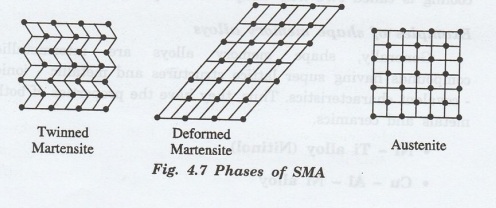
(i) Martensite is relatively soft. It is easily deformable yoпoupe
phase which exists at low temperature (monoclinic) (fig 4.8).
(ii) Austenite is a phase that occurs at high temperature having a
crystal structure and high degree of symmetry (cubic) (fig 4.8).
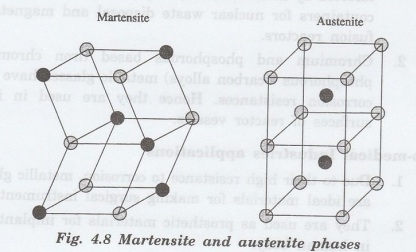
Types of Shape memory alloys
There
are two types of shape memory alloys
(i) One way shape memory alloy
(ii) Two way shape memory alloy
A material which exhibits shape memory
effect only upon heating is known as one-way
shape memory. A material which shows a shape memory effect during both
heating and cooling is called two-way
shape memory.
Examples
of shape memory alloys
Generally, shape memory alloys are
intermetallic compounds having super lattice structures and metallic ionic -
covalent characteristics. Thus, they have the properties of both metals and
ceramics.
• Ni - Ti alloy (Nitinol)
• Cu - Al- Ni alloy
•
Cu - Zn - Al alloy
• Au - Cd alloy
• Ni - Mn Ga and Fe based alloys
Note:
Now a days, shape memory alloys are also available in
nanophase structures.
Methods of Processing
The
shape memory alloys are generally prepared in vacuum or in an inert gas
atmosphere due to the high reactivity of the titanium present in the compound.
The methods such as plasma arc melting,
electron beam melting, vacuum induction, etc., are used for the commercial
preparations of shape memory alloys.
Characteristics of SMAS
1. Shape memory effect
The
change in shape of a material at low temperature by loading and regaining of
original shape by heating it, is known as shape memory effect.
The shape memory effect occurs in alloys
loys due to the chand to the change in their crystalline structure with the
change in temperature and stress.
• While loading,
twinned martensite becomes deformed martensite at low temperature.
• On heating, deformed martensite becomes austenite agnes
(shape recovery) and upon cooling it gets transformed to twinned martensite
(fig. 4.9).
2. SMAS exhibit changes in electrical
resistance, volume and length during the transformation with temperature.
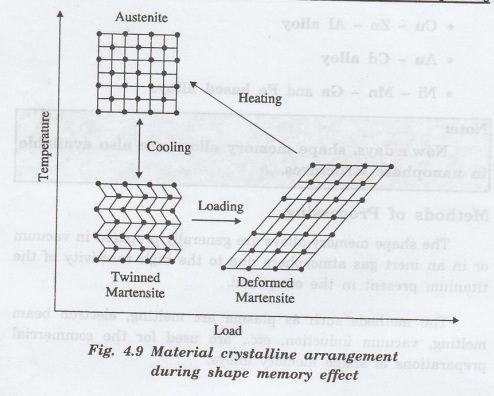
3. The mechanism involved in SMA is
reversible (austenite to martensite and vice versa.)
4. Strees and termperature have a great
influence on martensite transformation .
5. Pesudo elasticity
Pesudo-elasticity occurs in shape memory
alloys when it is completely in austenite phase (temperature is greater than Af
austenitefinish temperature
Unlike the shape memory effect,
Pseudo-elasticity occurs due to stress induced phase transformation without a
change in temperature. The load on the shape memory alloy changes austenite
phase into martensite( Fig 4.10)
As soon as the loading decreases the
matensite begins to transform to austenite and results in shape recovery.
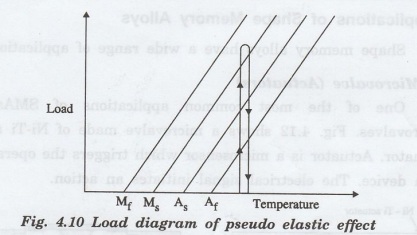
This
phenomenon of deformation of a SMA on application of large stress and regaining
of original shape on removal of the load is known as pseudo elasticity.
This
pseudo elasticity is also known as super elasticity.
6. Hysteresis
The
temperature range for the martensite to austenite transformation which takes
place upon heating is somewhat higher than that for the reverse transformation
upon cooling.
The difference between transition
temperature upon heating and cooling is called hysteresis. The hysteresis curve
for SMAS is shown in fig. 4.11.
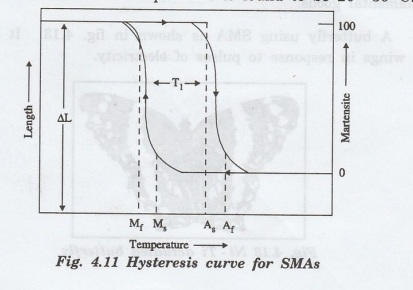
Applications of Shape Memory Alloys
Shape
memory alloys have a wide range of applications.
1. Microvalve
(Actuators)
One
of the most common applications of SMAs is microvalves. Fig. 4.12 shows a
microvalve made of Ni-Ti alloy actuator. Actuator is a microsensor which
triggers the operation of a device. The electrical signal initiates an action.
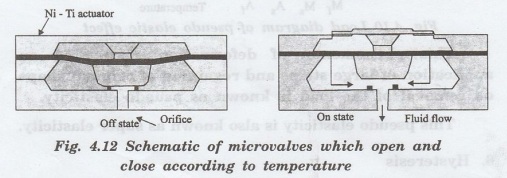
When
an electrical current of 50 to 150 mA flows in Ni - Ti actuator, it contracts
and lifts the poppet from the orifice and opens the valve.
2. Toys and novelties
Shape memory alloys are used to make
toys and ornamental goods.
A
butterfly using SMA as shown in fig. 4.13. It moves its wings in response to
pulses of electricity.
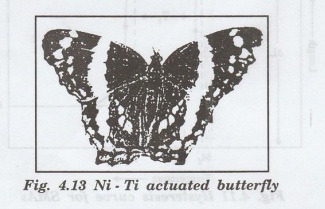
3. Medical field
Blood
clot filters
(i) Blood clot filters are SMAS, properly shaped and
inserted into veins to stop the
passing blood clots.
When the SMA is in contact with the clot
at a lower debar temperature, it expands and stops the clot and blood fais
passes through the veins.
(ii) They are used in artificial hearts.
(iii)
Orthodontic applications
Ni-Ti
wire holds the teeth tight with a constant stress irrespective of the strain
produced by the teeth movement. It resists permanent deformation even if it is bent.
Ni-Ti is non-toxic and non-corrosive with body fluid.
(iv)
SMAS (Ni-Ti) are used to make eye glass frames and medical tools. Sun-glasses
made from superelastic Ni-Ti frames provide good comfort and durability.
4. Antenna wires
The flexibility of superelastic Ni - Ti
wire makes it ideal for use as retractable antennas.
5. Thermostats
SMA
are used as thermostat to open and close the valves at required temperature.
6. Cryofit hydraulic couplings
SMAS
materials are used as couplings for metal pipes.
7. Springs, shock
absorbers and valves
Due
to the excellent elastic property of the SMAs, springs can be made which have
varied industrial applications. Some of them are listed here.
• Engine micro valves
• Medical stents (Stents are internal
inplant supports
• Firesafety valves and
• Aerospace latching mechanisms
8. Stepping motors
Digital
SMA stepping motors are used for robotic control.
9. Titanium-aluminium shape memory alloys
offer excellent strength with less weight and dominate in the aircraft
industry. They are high temperature SMAS, for possible use in aircraft engines
and other high temperature environments.
Advantages
of Shape Memory Alloys
• They are simple, compact and highly
safe.
• They have good bio - compatibility
• They have diverse applications and offer clean, silent and
spark-free working condition.
• They have good mechanical properties and strong
corrosion-resistance.
Disadvantages
of Shape Memory Alloys
• They have poor fatigue properties.
• They are expensive.
• They have low energy efficiency.
Physics For Civil Engineering: Unit IV: New Engineering Materials : Tag: : Phases, Types, Methods of Processing, Characteristics, Applications, Advantages, Disadvantages - Shape Memory Alloys (SMA)
Related Topics
Related Subjects
Physics for Civil Engineering
PH3201 2021 Regulation | 2nd Semester Civil Dept 2021 Regulation
